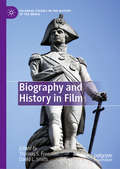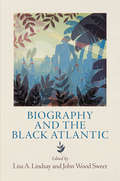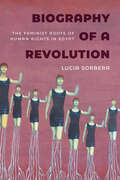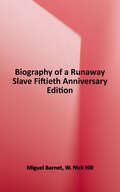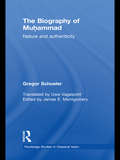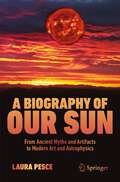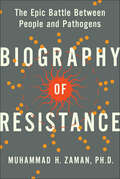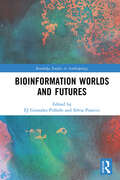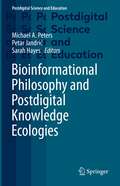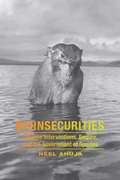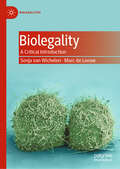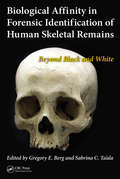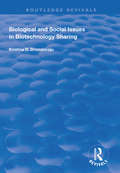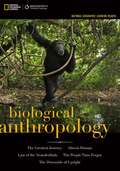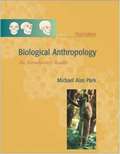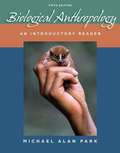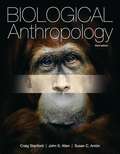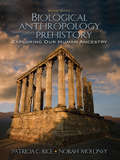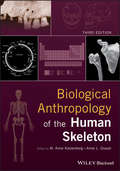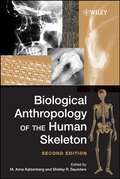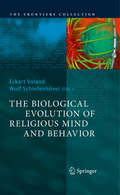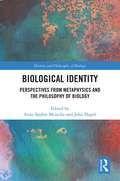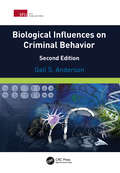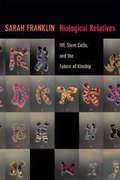- Table View
- List View
Biography and History in Film (Palgrave Studies in the History of the Media)
by Thomas S. Freeman David L. SmithThe essays in this volume seek to analyze biographical films as representations of historical individuals and the times in which they lived. To do this, contributors examine the context in which certain biographical films were made, including the state of knowledge about their subjects at that moment, and what these films reveal about the values and purposes of those who created them. This is an original approach to biographical (as opposed to historical) films and one that has so far played little part in the growing literature on historical films. The films discussed here date from the 1920s to the 2010s, and deal with males and females in periods ranging from the Middle Ages to the end of the twentieth century. In the process, the book discusses how biographical films reflect changing attitudes towards issues such as race, gender and sexuality, and examines the influence of these films on popular perceptions of the past. The introduction analyses the nature of biographical films as a genre: it compares and contrasts the nature of biography on film with written biographies, and considers their relationship with the discipline of history. As the first collection of essays on this popular but understudied genre, this book will be of interest to historians as well as those in film and cultural studies.
Biography and the Black Atlantic
by Lisa A. Lindsay John Wood SweetIn Biography and the Black Atlantic, leading historians in the field of Atlantic studies examine the biographies and autobiographies of eighteenth- and nineteenth-century African-descended people and reflect on the opportunities and limitations these life stories present to studies of slavery and the African diaspora. The essays remind us that historical developments like slavery and empire-building were mostly experienced and shaped by men and women outside of the elite political, economic, and military groups whom historians often turn to as sources.Despite the scarcity of written records and other methodological challenges, the contributors to Biography and the Black Atlantic have pieced together vivid glimpses into lives of remarkable, through previously unknown, enslaved and formerly enslaved people who moved, struggled, and endured in different parts of Africa, the Americas, and Europe. From the woman of Fulani origin who made her way from Revolutionary Haiti to Louisiana to the free black American who sailed for Liberia and the former slave from Brazil who became a major slave trader in Angola, these stories render the Atlantic world as a densely and sometimes unpredictably interconnected sphere. Biography and the Black Atlantic demonstrates the power of individual stories to illuminate history: though the life histories recounted here often involved extraordinary achievement and survival against the odds, they also portray the struggle for self-determination and community in the midst of alienation that lies at the heart of the modern condition.Contributors: James T. Campbell, Vincent Carretta, Roquinaldo Ferreira, Jean-Michel Hébrard, Martin Klein, Lloyd S. Kramer, Sheryl Kroen, Jane Landers, Lisa A. Lindsay, Joseph C. Miller, Cassandra Pybus, João José Reis, Rebecca J. Scott, Jon Sensbach, John Wood Sweet.
Biography of a Revolution: The Feminist Roots of Human Rights in Egypt
by Dr. Lucia SorberaIt is not Egypt's 2011 revolution that opened a space for women's and feminist activism, but—as this book shows—the long history of women's activism that created the intellectual and political background for revolution. By centering the experiences and ideas of multiple generations of women activists and intellectuals, Lucia Sorbera traces the feminist genealogies of Egypt's nationalist, student, Marxist, labor, human rights, and democratic social movements. Biography of a Revolution gathers a series of interrelated intimate and relational stories, charting in vivid detail the entanglements between women's aspirations across a century of politics and friendships. This historical analysis innovatively deploys decolonial and indigenous feminist epistemologies, bringing women's, gender, and feminist history into the center of Egypt's political, social, and intellectual history. More than a decade after the 2013 military coup, women's intellectual and political activism remains crucial to keeping the embers of revolution aglow.
Biography of a Runaway Slave: Fiftieth Anniversary Edition
by Miguel BarnetFiftieth Anniversary Edition Originally published in 1966, Miguel Barnet's Biography of a Runaway Slave provides the written history of the life of Esteban Montejo, who lived as a slave, as a fugitive in the wilderness, and as a soldier fighting against Spain in the Cuban War of Independence. A new introduction by one of the most preeminent Afro-Hispanic scholars, William Luis, situates Barnet's ethnographic strategy and lyrical narrative style as foundational for the tradition of testimonial fiction in Latin American literature. Barnet recorded his interviews with the 103-year-old Montejo at the onset of the Cuban Revolution. This insurgent's history allows the reader into the folklore and cultural history of Afro-Cubans before and after the abolition of slavery. The book serves as an important contribution to the archive of the black experience in Cuba and as a reminder of the many ways that the present continues to echo the past.
The Biography of Muhammad: Nature and Authenticity
by Gregor SchoelerThis book considers the Arabic biographies of Prophet Muhammad, the earliest of which dates from two centuries after his life. These biographies, prized by Muslims, have been approached in the Western study of Islam from a range of positions. Some scholars reject them entirely, seeing in them products of the Muslim community’s idealisation of its history, while others accept them at face value, reasoning that, if not exact versions of events, the events could not have differed too much from their descriptions. The author revisits the debate and reconsiders several key incidents in the life of the Prophet. By compiling an extensive corpus of materials and comparing them closely, this book analyses the transmission and the contents of the accounts. It shows that by understanding clearly the interaction in early Islam between written and oral modes of transmission, and by the judicious sieving of the accounts, as well as the lines of transmission, we can sometimes reach back to that generation of Muslims who though not themselves witness to the events were younger contemporaries of those who were. Establishing a solid basis for the informed study of Muhammad’s biography and adding to the ongoing debate, this book will appeal to scholars of early Islam, history and theology.
A Biography of Our Sun: From Ancient Myths and Artifacts to Modern Art and Astrophysics
by Laura PesceThis book is for everyone curious about the Sun and how it has been perceived throughout human history, including the modern scientific view. Beginning with ancient myths and legends, superstitions, art and poetry, the book proceeds to explain the amazing composition of our star, how it produces the heat and light on which all life depends, as well as touching the harvesting of solar energy that is becoming so essential in the modern world. The book is illustrated by the author's own artwork and includes first-hand scientific information provided in interviews with professional astrophysicists.
Biography of Resistance: The Epic Battle Between People and Pathogens
by Muhammad H. ZamanAward-winning Boston University educator and researcher Muhammad H. Zaman provides a chilling look at the rise of antibiotic-resistant superbugs, explaining how we got here and what we must do to address this growing global health crisis.In September 2016, a woman in Nevada became the first known case in the U.S. of a person who died of an infection resistant to every antibiotic available. Her death is the worst nightmare of infectious disease doctors and public health professionals. While bacteria live within us and are essential for our health, some strains can kill us. As bacteria continue to mutate, becoming increasingly resistant to known antibiotics, we are likely to face a public health crisis of unimaginable proportions. “It will be like the great plague of the middle ages, the influenza pandemic of 1918, the AIDS crisis of the 1990s, and the Ebola epidemic of 2014 all combined into a single threat,” Muhammad H. Zaman warns.The Biography of Resistance is Zaman’s riveting and timely look at why and how microbes are becoming superbugs. It is a story of science and evolution that looks to history, culture, attitudes and our own individual choices and collective human behavior. Following the trail of resistant bacteria from previously uncontacted tribes in the Amazon to the isolated islands in the Arctic, from the urban slums of Karachi to the wilderness of the Australian outback, Zaman examines the myriad factors contributing to this unfolding health crisis—including war, greed, natural disasters, and germophobia—to the culprits driving it: pharmaceutical companies, farmers, industrialists, doctors, governments, and ordinary people, all whose choices are pushing us closer to catastrophe.Joining the ranks of acclaimed works like Microbe Hunters, The Emperor of All Maladies, and Spillover, A Biography of Resistance is a riveting and chilling tale from a natural storyteller on the front lines, and a clarion call to address the biggest public health threat of our time.
Bioinformation Worlds and Futures (Routledge Studies in Anthropology)
by Ej Gonzalez-PolledoThis book sets out to define and consolidate the field of bioinformation studies in its transnational and global dimensions, drawing on debates in science and technology studies, anthropology and sociology. It provides situated analyses of bioinformation journeys across domains and spheres of interpretation. As unprecedented amounts of data relating to biological processes and lives are collected, aggregated, traded and exchanged, infrastructural systems and machine learners produce real consequences as they turn indeterminate data into actionable decisions for states, companies, scientific researchers and consumers. Bioinformation accrues multiple values as it transverses multiple registers and domains, and as it is transformed from bodies to becoming a subject of analysis tied to particular social relations, promises, desires and futures. The volume harnesses the anthropological sensibility for situated, fine-grained, ethnographically grounded analysis to develop an interdisciplinary dialogue on the conceptual, political, social and ethical dimensions posed by bioinformation.
Bioinformational Philosophy and Postdigital Knowledge Ecologies (Postdigital Science and Education)
by Michael A. Peters Petar Jandrić Sarah HayesThe book presents a cross-disciplinary overview of critical issues at the intersections of biology, information, and society. Based on theories of bioinformationalism, viral modernity, the postdigital condition, and others, this book explores two inter-related questions: Which new knowledge ecologies are emerging? Which philosophies and research approaches do they require? The book argues that the 20th century focus on machinery needs to be replaced, at least partially, by a focus on a better understanding of living systems and their interactions with technology at all scales – from viruses, through to human beings, to the Earth’s ecosystem. This change of direction cannot be made by a simple relocation of focus and/or funding from one discipline to another. In our age of the Anthropocene, (human and planetary) biology cannot be thought of without (digital) technology and society. Today’s curious bioinformational mix of blurred and messy relationships between physics and biology, old and new media, humanism and posthumanism, knowledge capitalism and bio-informational capitalism defines the postdigital condition and creates new knowledge ecologies. The book presents scholarly research defining new knowledge ecologies built upon emerging forms of scientific communication, big data deluge, and opacity of algorithmic operations. Many of these developments can be approached using the concept of viral modernity, which applies to viral technologies, codes and ecosystems in information, publishing, education, and emerging knowledge (journal) systems. It is within these overlapping theories and contexts, that this book explores new bioinformational philosophies and postdigital knowledge ecologies.
Bioinsecurities: Disease Interventions, Empire, and the Government of Species
by Neel AhujaIn Bioinsecurities Neel Ahuja argues that U.S. imperial expansion has been shaped by the attempts of health and military officials to control the interactions of humans, animals, viruses, and bacteria at the borders of U.S. influence, a phenomenon called the government of species. The book explores efforts to control the spread of Hansen's disease, venereal disease, polio, smallpox, and HIV through interventions linking the continental United States to Hawai'i, Panamá, Puerto Rico, Cuba, Congo, Iraq, and India in the twentieth and twenty-first centuries. Ahuja argues that racial fears of contagion helped to produce public optimism concerning state uses of pharmaceuticals, medical experimentation, military intervention, and incarceration to regulate the immune capacities of the body. In the process, the security state made the biological structures of human and animal populations into sites of struggle in the politics of empire, unleashing new patient activisms and forms of resistance to medical and military authority across the increasingly global sphere of U.S. influence.
Biolegality: A Critical Introduction (Biolegalities)
by Marc de Leeuw Sonja van WichelenThis book provides a comprehensive analysis of the empirical and theoretical problems posed by the encounter between law and biology in the twenty-first century. How does biotechnology and new bioscientific knowledge affect our legal institutions, our sense of justice, and our ways of relating to one another? To answer these questions, authors Marc de Leeuw and Sonja van Wichelen examine the complex and often contested ways in which biotechnology and biological knowledge are reworked by, with, and against legal knowledge. As this book shows, recent developments in the life sciences—including molecular biology, immunology, and the neurosciences—and their applications in forensics, medicine, and agriculture test longstanding legal forms, such as property, personhood, parenthood, and (collective) identity, ultimately constituting the current field of “biolegality.” The authors argue that these biolegal contestations represent philosophical and anthropological challenges to existing understandings of exchange, self, kinship, and community. By addressing how biology and law inform new ways of relating and knowing, the book proposes a programmatic intervention, asserting the pivotal role the study of biolegality plays in advancing social and political theory.
Biological Affinity in Forensic Identification of Human Skeletal Remains: Beyond Black and White
by Gregory E. Berg Sabrina C. Ta’alaAncestry determination in the identification of unknown remains can be a challenge for forensic scientists and anthropologists, especially when the remains available for testing are limited. There are various techniques for the assessment of ancestry, ranging from traditional to new microbiological and computer-assisted methods. Biological Affinity
Biological and Social Issues in Biotechnology Sharing (Routledge Revivals)
by Krishna R. DronamrajuFirst published in 1998, this was the first book to present a comprehensive summary of both the global as well as institutional issues which are involved in biotechnology sharing. It covers the controversial subject of intellectual property rights (IPR) and the patenting of new discoveries in genetic knowledge in both agriculture and the human genome. One controversial issue is the creation of public and private DNA sequencing data bases. Of special interest is the sharing of biotechnology between the developed (rich) and developing (poor) nations. A related topic which requires immediate attention is the exploitation of biodiversity in the developing countries and the resulting extinction of rare species. Sharing or transferring biotechnology and its applications between institutions or different countries raises numerous ethical and moral dilemmas. A comprehensive summary of these issues is presented in this book.
Biological Anthropology
by National Geographic Learning StaffBring your learning to life with compelling images, media and text from National Geographic. National Geographic Reader: Biological Anthropology will help you develop a clearer understanding of the world around you through engaging content.
Biological Anthropology: An Introductory Reader 3rd ed.
by Michael Alan ParkThis supplementary reader demonstrates the significant contributions made by biological anthropology.
Biological Anthropology: An Introductory Reader
by Michael Alan ParkThis supplementary reader offers both historical and contemporary articles that demonstrate the nature and significant contributions of biological anthropology. With nearly one-third of the selections focusing on living populations, the 42 readings cover the entire range of bioanthropological studies: evolution, nonhuman primates, human paleontology, and modern human groups. Eleven of the articles are new to this edition, including Adam Summer's "Born to Run," Kate Wong's "The Littlest Human," James J. McKenna's "Babies Need Their Mothers Beside Them," and Michael Balter's "Are Humans Still Evolving?"
Biological Anthropology (3rd Edition)
by Craig Stanford John S. Allen Susan C. AntonDiscover the Best of Biological Anthropology: From its Earliest Foundations to its Most Current Innovations Biological Anthropology, 3/e is written to appeal to a wide range of students. It continues to build upon the strength and success of its first and second editions by integrating the foundations of the field with the most current innovations happening today. Over the past 40 years, biological anthropology has rapidly evolved from the study of physical anthropology into biological anthropology. Biological anthropology is now an integrative combination of information from the fossil record and the human skeleton, genetics of individuals and of populations, our primate relatives, human adaptation, and human behavior. The third edition of Biological Anthropology combines the most up-to-date, comprehensive coverage of the foundations of the field with modern innovations and discoveries. Teaching and Learning Experience Personalize Learning - MyAnthroLab delivers proven results in helping students succeed, provides engaging experiences that personalize learning, and comes from a trusted partner with educational expertise and a deep commitment to helping students and instructors achieve their goals. Improve Critical Thinking - Visual summaries, critical thinking questions, Insights and Advances boxes and author suggested readings found within each chapter encourage students to examine assumptions, discern hidden values, evaluate evidence, assess conclusions, and more!
Biological Anthropology and Prehistory: Exploring Our Human Ancestry
by Patricia C. Rice Norah MoloneyWritten specifically for courses that cover biological anthropology and archaeology, this superbly illustrated new text offers the most balanced and up-to-date introduction to our human past. Devoting equal time to biological anthropology and prehistory, this text exposes students to the many sides of major controversial issues, involving students in the scientific thought process by allowing them to draw their own conclusions. Amidst discussions of bones and artifacts, the text maintains a focus on people, demonstrating to students how biological anthropology and archaeology apply to their lives today. Featuring the latest research and findings pulled from the original sources, this new text is far and away the most up-to-date text available. In addition, the superior art program features hundreds of photographs and figures, and the multimedia presentation options include documentary film clips and lecture launcher videos. Pat Rice, a recipient of AAA’s Outstanding Teacher Award and past-president of the General Anthropology Division of AAA, and Norah Moloney, an experienced professor and active archaeologist, present the material in a clear, refreshing, and straightforward writing style.
Biological Anthropology of the Human Skeleton
by M. Anne Katzenberg Anne L. GrauerAn Indispensable Resource on Advanced Methods of Analysis of Human Skeletal and Dental Remains in Archaeological and Forensic Contexts Now in its third edition, Biological Anthropology of the Human Skeleton has become a key reference for bioarchaeologists, human osteologists, and paleopathologists throughout the world. It builds upon basic skills to provide the foundation for advanced scientific analyses of human skeletal remains in cultural, archaeological, and theoretical contexts. This new edition features updated coverage of topics including histomorphometry, dental morphology, stable isotope methods, and ancient DNA, as well as a number of new chapters on paleopathology. It also covers bioarchaeological ethics, taphonomy and the nature of archaeological assemblages, biomechanical analyses of archaeological human skeletons, and more. Fully updated and revised with new material written by leading researchers in the field Includes many case studies to demonstrate application of methods of analysis Offers valuable information on contexts, methods, applications, promises, and pitfalls Covering the latest advanced methods and techniques for analyzing skeletal and dental remains from archaeological discoveries, Biological Anthropology of the Human Skeleton is a trusted text for advanced undergraduates, graduate students, and professionals in human osteology, bioarchaeology, and paleopathology.
Biological Anthropology of the Human Skeleton
by M. Anne Katzenberg Shelley R. Saunders"This book is virtually required reading for biological anthropologists and will be a useful, up-to-date primer on osteological analyses for a wider audience."--The Quarterly Review of Biology, March 2009"... a comprehensive guide to the ever-changing discipline of physical anthropology... provides an in depth introduction to human skeletal biology. The structure of the book makes it easy for the reader to follow the progression of the field of human skeletal biology."--PaleoAnthropology, 2009 IssueThe First Edition of Biological Anthropology of the Human Skeleton is the market-leading reference and textbook on the scientific analysis of human skeletal remains recovered from archaeological sites. Now, featuring scores of new or thoroughly revised content, this Second Edition provides the most comprehensive and up-to-date coverage of the topic available.Like the previous edition, this Second Edition is organized into five parts with contributing chapters written by experts in the field of human skeletal biology: Part One covers theory and application; Part Two discusses morphological analyses of bone, teeth, and age changes; Part Three reviews prehistoric health and disease; Part Four examines chemical and genetic analysis of hard tissues; and Part Five closes with coverage of quantitative methods and population studies. Each chapter includes a review of recent studies, descriptions of analytical techniques and underlying assumptions, theory, methodological advances, and speculation about future research.New or thoroughly revised content includes:Techniques in the analysis of human skeletal and dental remainsExtensive coverage of new technologies, including modern morphometric techniquesAdvances in the field of forensic anthropologyEnhanced discussion of ethical terms regarding the study of aboriginal peoples' remains where those people are no longer the dominant cultureThis book serves as an indispensable research guide to biological anthropologists, osteologists, paleoanthropologists, and archaeologists. Now with a stronger focus on teaching complex material to students, this revised edition provides enhanced case studies and discussions for future directions, making it an invaluable textbook for advanced undergraduates and graduate students in biological anthropology and forensic anthropology programs.
Biological Consequences of Socioeconomic Inequalities, The
by Barbara Wolfe Teresa E. Seeman William EvansSocial scientists have repeatedly uncovered a disturbing feature of economic inequality: people with larger incomes and better education tend to lead longer, healthier lives. This pattern holds across all ages and for virtually all measures of health, apparently indicating a biological dimension of inequality. But scholars have only begun to understand the complex mechanisms that drive this disparity. How exactly do financial well-being and human physiology interact? The Biological Consequences of Socioeconomic Inequalities incorporates insights from the social and biological sciences to quantify the biology of disadvantage and to assess how poverty gets under the skin to impact health. Drawing from unusually rich datasets of biomarkers, brain scans, and socioeconomic measures, Biological Consequences of Socioeconomic Inequalities illustrates exciting new paths to understanding social inequalities in health. Barbara Wolfe, William N. Evans and Nancy Adler begin the volume with a critical evaluation of the literature on income and health, providing a lucid review of the difficulties of establishing clear causal pathways between the two variables. In their chapter, Arun S. Karlamangla, Tara L. Gruenewald, and Teresa E. Seeman outline the potential of biomarkers—such as cholesterol, heart pressure, and C-reactive protein—to assess and indicate the factors underlying health. Edith Chen, Hannah M. C. Schreier, and Meanne Chan reveal the empirical power of biomarkers by examining asthma, a condition steeply correlated with socioeconomic status. Their analysis shows how stress at the individual, family, and neighborhood levels can increase the incidence of asthma. The volume then turns to cognitive neuroscience, using biomarkers in a new way to examine the impact of poverty on brain development. Jamie Hanson, Nicole Hair, Amitabh Chandra, Ed Moss, Jay Bhattacharya, Seth D. Pollack, and Barbara Wolfe use a longitudinal Magnetic Resonance Imaging (MRI) study of children between the ages of four and eighteen to study the link between poverty and limited cognition among children. Michelle C. Carlson, Christopher L. Seplaki, and Teresa E. Seeman also focus on brain development to examine the role of socioeconomic status in cognitive decline among older adults. Featuring insights from the biological and social sciences, Biological Consequences of Socioeconomic Inequalities will be an essential resource for scholars interested in socioeconomic disparities and the biological imprint that material deprivation leaves on the human body.
The Biological Evolution of Religious Mind and Behavior
by Eckart Voland Wulf SchiefenhövelIn a Darwinian world, religious behavior - just like other behaviors - is likely to have undergone a process of natural selection in which it was rewarded in the evolutionary currency of reproductive success. This book aims to provide a better understanding of the social scenarios in which selection pressure led to religious practices becoming an evolved human trait, i.e. an adaptive answer to the conditions of living and surviving that prevailed among our prehistoric ancestors. This aim is pursued by a team of expert authors from a range of disciplines. Their contributions examine the relevant physiological, emotional, cognitive and social processes. The resulting understanding of the functional interplay of these processes gives valuable insights into the biological roots and benefits of religion.
Biological Identity: Perspectives from Metaphysics and the Philosophy of Biology (History and Philosophy of Biology)
by Anne Sophie MeinckeAnalytic metaphysics has recently discovered biology as a means of grounding metaphysical theories. This has resulted in long-standing metaphysical puzzles, such as the problems of personal identity and material constitution, being increasingly addressed by appeal to a biological understanding of identity. This development within metaphysics is in significant tension with the growing tendency amongst philosophers of biology to regard biological identity as a deep puzzle in its own right, especially following recent advances in our understanding of symbiosis, the evolution of multi-cellular organisms and the inherently dynamical character of living systems. Moreover, and building on these biological insights, the broadly substance ontological framework of metaphysical theories of biological identity appears problematic to a growing number of philosophers of biology who invoke process ontology instead. This volume addresses this tension, exploring to what extent it can be dissolved. For this purpose, the volume presents the first selection of essays exclusively focused on biological identity and written by experts in metaphysics, the philosophy of biology and biology. The resulting cross-disciplinary dialogue paves the way for a convincing account of biological identity that is both metaphysically constructive and scientifically informed, and will be of interest to metaphysicians, philosophers of biology and theoretical biologists.
Biological Influences on Criminal Behavior
by Gail AndersonBiological Influences on Criminal Behavior, Second Edition is fully updated to include recent research, studies, and publications examining the integration of the biological view with mainstream social, psychological, and environmental views in influences in criminality and criminal behavior. The first edition of the book was written with the belief, grounded in research, that something vital can be discovered when we assess all the factors related to the causes of crime, including biology. Since the first edition published, it has become broadly accepted that biology is certainly a factor in criminal behavior, albeit a singular piece to the puzzle. Increased collaborations between scientists and criminologists has led to a much stronger understanding of the intricacies of biology’s role in behavior. As well, more criminologists have biological backgrounds. As the science involved became more complex, so too did this text. This second edition considers the more recent and integrated research that is being conducted today to show the interaction between the environment and a person’s biology that lead to our behavior. It has even been shown that the environment acts on, and actually changes the functions, of some genes. The book begins with basic scientific principles and advances to introduce the reader to the more in-depth discussions of various biological influencers. Biological Influences on Criminal Behavior, Second Edition is written primarily for social science and law students who wish to understand this exciting area. The book offers a greater understanding of this rapidly growing field so that its lessons can help to inform policy, treatments, rehabilitation and the law.
Biological Relatives: IVF, Stem Cells, and the Future of Kinship
by Sarah FranklinThirty-five years after its initial success as a form of technologically assisted human reproduction, and five million miracle babies later, in vitro fertilization (IVF) has become a routine procedure worldwide. In Biological Relatives, Sarah Franklin explores how the normalization of IVF has changed how both technology and biology are understood. Drawing on anthropology, feminist theory, and science studies, Franklin charts the evolution of IVF from an experimental research technique into a global technological platform used for a wide variety of applications, including genetic diagnosis, livestock breeding, cloning, and stem cell research. She contends that despite its ubiquity, IVF remains a highly paradoxical technology that confirms the relative and contingent nature of biology while creating new biological relatives. Using IVF as a lens, Franklin presents a bold and lucid thesis linking technologies of gender and sex to reproductive biomedicine, contemporary bioinnovation, and the future of kinship.
